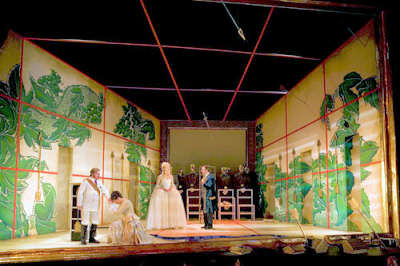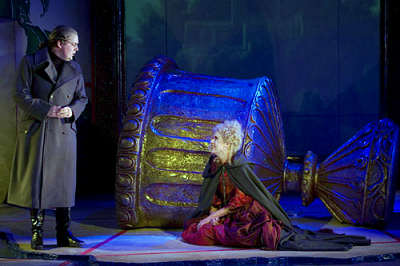Mozart, Il re
pastore: The Royal Opera in the Linbury Studio
Theatre, 13.4.06 (ED)
Aminta: Katie Van Kooten (soprano)*
Elisa: Ana James (soprano)*
Alessandro: Peter Bronder (tenor)
Agenor: Robert Murray (tenor)*
Tamiri: Anna Leese (soprano)
English Baroque Soloists
Edward Gardner, conductor
* Participants in the Jette Parker Young Artists Programme
Director, set designs and lighting: John Lloyd Davies
Costumes: Susanne Hubrich

Il re pastore can be said to be a work of transition
for Mozart in several respects. The music is noticeably
more in his own style than in the stage works that preceded
it (Lucio Silla, Ascanio in Alba and La
finta giardiniera) whilst testing the limits of 18th-century
operatic convention. The work itself shows the sowing
of seeds that would bear fruit in Idomeneo and
Così fan tutte, both of which marry moral
questions to musical complexities of extraordinary richness.
When Mozart set Metastasio’s libretto in 1775 for
the visit of Archduke Maximillian to Salzburg it had already
been set by some 13 composers, though Mozart’s setting
shows some textual alterations to increase dramatic possibilities,
not least the inclusion of a suitable closing quintet
to honour the royal visitor. Due in part to the lack of
an opera house in Salzburg Mozart never saw the work staged,
but when done sensitively it is possible to bring out
the dramatic possibilities even though both characters
and plot prove themselves ‘squeaky clean’
in every respect. Aminta, a shepherd, is found by Allessandro
to be the rightful king of Sidon, a country he has just
conquered. Aminta’s love for Elisa, a peasant girl,
is thwarted by Allessandro’s desire to marry him
to Tamiri, who is secretly loved by Agenor, Allessandro’s
aide. That Allessandro accepts true love and nobleness
of action as of greater value than kingship is the final
outcome, as he unites both pairs according to their wishes.

Being of perfect scale for the Linbury Studio Theatre,
this production lacked nothing in the dedication of the
cast to present a cogent case for the work. With stage
direction that was well conceived one could sense the
dilemmas faced by the characters as much through their
actions as their singing, adding emotional depth to the
evening. Occasionally some aspects of the production seemed
contrived to the point of distracting from the action:
why in moments of decision was Allessandro standing upon
a platform surrounded by arrow carrying soldiers?
Such things however could not detract from the obvious
musical merits of this production. Katie Van Kooten consolidated
her burgeoning reputation as a rising star soprano with
a portrayal of Aminta that was sung and acted with ardour.
Her voice being of slightly fuller tone than that of Ana
James, who projected honest femininity with ease, lent
their duet passages particular credibility. Robert Murray’s
Agenor was also well assumed and solidly voiced, and particularly
in Act II succeeded in suggesting internal frustrations
when words were denied him. If one needed reminding of
the value of the Jette Parker Young Artists Programme,
these three artists gave it in spades.
The other two sung roles were also taken by singers of
note. Anna Leese as Tamiri was vocally polished and forthright
in her acting. Peter Bronder’s Allessandro was something
of an acquired taste given his occasionally effortful
vocal production, however he lacked for little in terms
of dynamism.
The English Baroque Soloists provided robust support for
proceedings and playing of quality with piquant contributions
from winds and brass, which in particular helped to bring
out the textural qualities inherent in the scoring of
Act II. Edward Gardner, English National Opera’s
recently appointed music director designate, directed
with unfailing vitality to give a reading that was full
of dramatic energy, yet also showed awareness that as
a chamber opera the dynamic should relax for moments of
inner reflection. Just as the opera shows Mozart’s
compositional qualities in the making, this production
is worth hearing for the music and the young team of performers
who deliver it most affectionately.
Evan Dickerson
© Royal Opera House, Covent Garden, photographer,
Johan Persson

